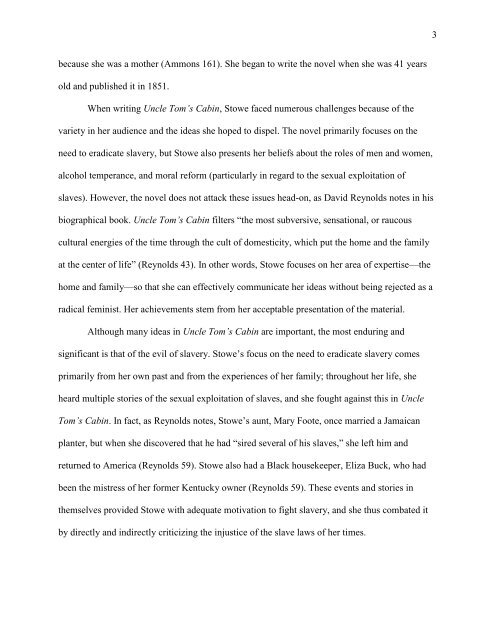Uncle Tom's Cabin
Uncle Tom's Cabin
Uncle Tom's Cabin
Create successful ePaper yourself
Turn your PDF publications into a flip-book with our unique Google optimized e-Paper software.
3<br />
because she was a mother (Ammons 161). She began to write the novel when she was 41 years<br />
old and published it in 1851.<br />
When writing <strong>Uncle</strong> Tom’s <strong>Cabin</strong>, Stowe faced numerous challenges because of the<br />
variety in her audience and the ideas she hoped to dispel. The novel primarily focuses on the<br />
need to eradicate slavery, but Stowe also presents her beliefs about the roles of men and women,<br />
alcohol temperance, and moral reform (particularly in regard to the sexual exploitation of<br />
slaves). However, the novel does not attack these issues head-on, as David Reynolds notes in his<br />
biographical book. <strong>Uncle</strong> Tom’s <strong>Cabin</strong> filters “the most subversive, sensational, or raucous<br />
cultural energies of the time through the cult of domesticity, which put the home and the family<br />
at the center of life” (Reynolds 43). In other words, Stowe focuses on her area of expertise—the<br />
home and family—so that she can effectively communicate her ideas without being rejected as a<br />
radical feminist. Her achievements stem from her acceptable presentation of the material.<br />
Although many ideas in <strong>Uncle</strong> Tom’s <strong>Cabin</strong> are important, the most enduring and<br />
significant is that of the evil of slavery. Stowe’s focus on the need to eradicate slavery comes<br />
primarily from her own past and from the experiences of her family; throughout her life, she<br />
heard multiple stories of the sexual exploitation of slaves, and she fought against this in <strong>Uncle</strong><br />
Tom’s <strong>Cabin</strong>. In fact, as Reynolds notes, Stowe’s aunt, Mary Foote, once married a Jamaican<br />
planter, but when she discovered that he had “sired several of his slaves,” she left him and<br />
returned to America (Reynolds 59). Stowe also had a Black housekeeper, Eliza Buck, who had<br />
been the mistress of her former Kentucky owner (Reynolds 59). These events and stories in<br />
themselves provided Stowe with adequate motivation to fight slavery, and she thus combated it<br />
by directly and indirectly criticizing the injustice of the slave laws of her times.











